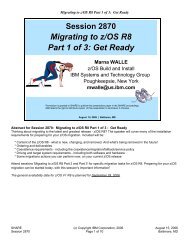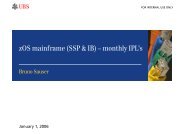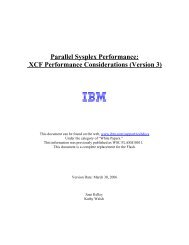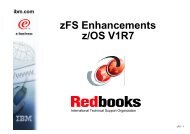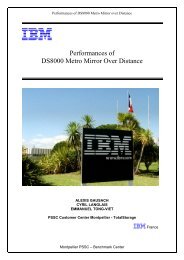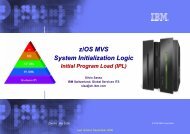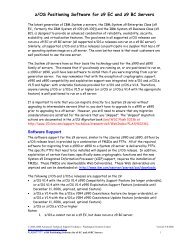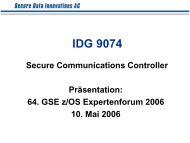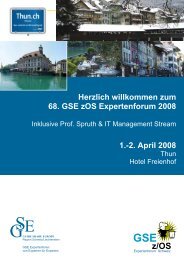Hot Topics - Messmer The Brain House
Hot Topics - Messmer The Brain House
Hot Topics - Messmer The Brain House
Create successful ePaper yourself
Turn your PDF publications into a flip-book with our unique Google optimized e-Paper software.
Figure 2 - Relationship between the components of a domain policy<br />
EWLM will apply to the EWLM<br />
domain.<br />
• Operating: You can display the<br />
operational state of EWLM and of<br />
each server in a management domain,<br />
as well as trigger activities that alter<br />
operational states. You can query the<br />
identity of the service policy that is<br />
currently in effect for the management<br />
domain and initiate activation of a<br />
specific service policy by policy name.<br />
• Monitoring: EWLM tracks and<br />
monitors work as it flows from one<br />
application or server to another,<br />
regardless of operating system. It<br />
monitors application-level transactions,<br />
operating system processes, or both.<br />
EWLM provides the most granular<br />
performance data when it monitors<br />
application-level transactions because<br />
the applications use the Open Group’s<br />
Application Response Measurement<br />
(ARM) 4.0 standard APIs. <strong>The</strong>se<br />
APIs are your mechanic’s true<br />
diagnostic tools—they allow EWLM<br />
to monitor a transaction as it hops<br />
from one application to another to<br />
continue processing. This allows<br />
you to determine at which hop a<br />
performance problem exists.<br />
Manage your fleet: Application<br />
instrumentation with ARM 4.0<br />
To ensure that work requests are<br />
performing as expected in a multi-tiered<br />
heterogeneous server environment, you<br />
must be able to identify work requests<br />
based on business importance, track the<br />
performance of those requests across server<br />
and subsystem boundaries, and manage<br />
the underlying physical and network<br />
resources used to achieve specified<br />
performance goals. You can collect this<br />
data by using versions of middleware that<br />
have been instrumented with the ARM 4.0<br />
standard.<br />
ARM 4.0 provides interfaces that are<br />
first called by an application and then<br />
used by EWLM to calculate the response<br />
time and status of work processed by<br />
the application. EWLM is responsible<br />
for aggregating and reporting the data<br />
collected from each managed server in a<br />
particular management domain. Using a<br />
standard, such as the ARM 4.0 interfaces,<br />
allows an operating environment,<br />
regardless of platform, to leverage the same<br />
set of base measurements.<br />
Brief your drivers: Domain policies<br />
A domain policy specifies performance<br />
goals for work processed in the EWLM<br />
domain. Each domain policy contains the<br />
following elements:<br />
• Application definitions, which provide<br />
transactions for EWLM to monitor.<br />
• Platform definitions (optional), which<br />
provide operating system processes for<br />
EWLM to monitor.<br />
• Transaction classes, which identify<br />
application-level transactions for<br />
EWLM to monitor.<br />
• Process classes (optional), which<br />
identify operating system processes for<br />
EWLM to monitor.<br />
• Partition classes (optional), which<br />
identify partitions for EWLM to<br />
monitor.<br />
• Performance goals defined in<br />
service classes that correspond to<br />
your business objectives or business<br />
partners' service level agreements.<br />
• Multiple service policies, if you want<br />
to change a service class goal from<br />
one service policy to another.<br />
Figure 2 shows the relationship between a<br />
domain policy’s components.<br />
Start your engines: Incorporate<br />
EWLM into your environment<br />
So, have we inspired you to satisfy your<br />
need for speed? If you’re interested<br />
in implementing EWLM in your own<br />
heterogeneous environment, race on over<br />
to the IBM Systems Software Information<br />
Center (publib.boulder.ibm.com/<br />
infocenter/eserver/v1r2/index.jsp) for more<br />
information. Enjoy the ride!<br />
I never knew that<br />
mainframes were so widely used<br />
throughout the whole world!<br />
Van Landrum,<br />
University of South Alabama<br />
February 2006 z/OS HOT TOPICS Newsletter, Issue 14 47




